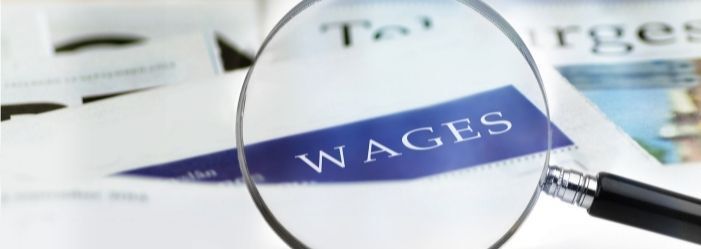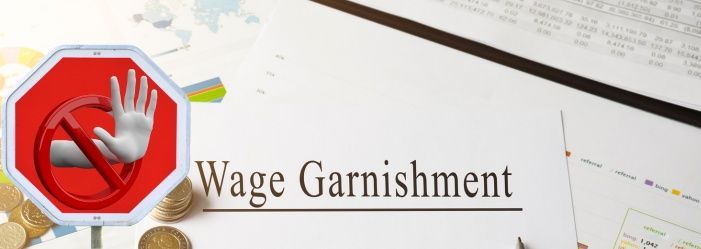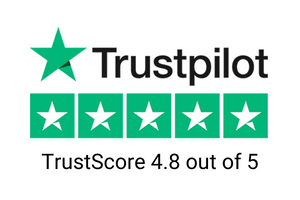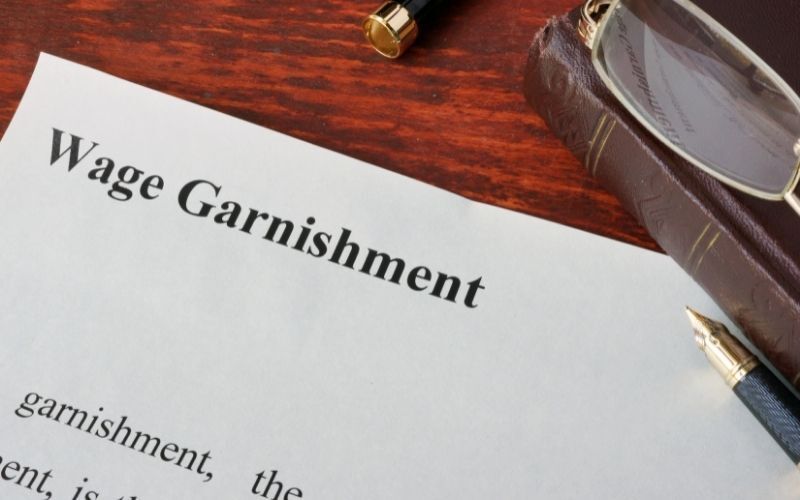Last Updated: August 1, 2024
What can I do if I am facing a garnishment?

Disclaimer: We are not qualified legal or tax professionals and are not giving advice. Always speak with a qualified professional before making any legal or financial decisions.
Facing wage garnishment can be stressful and challenging, but it's important to know you have options to stop a garnishment in its tracks. Whether through negotiating with creditors, challenging the order, or exploring legal avenues like bankruptcy, taking quick and informed action can protect your finances and future.
This guide will walk you through straightforward and effective steps to stop a garnishment and regain control of your financial well-being. You'll learn practical strategies to halt the process and explore alternatives that can help you confidently move forward.
Want to skip the article and speak directly to a debt specialist? Click here for a free consultation.
Wage Garnishment
Wage garnishment is a legal process where creditors can deduct money directly from your paycheck or bank account. Common causes include child support, alimony, consumer debt, and federal student loans. However, you can take action to stop a garnishment. Understanding your rights and options to halt this process can help protect your finances and provide peace of mind. Explore the nuances of how creditors garnish wages for self-employed individuals.
Government entities can garnish wages without a court order for certain debts. To stop a garnishment, pay bills on time to prevent it, check if your income is protected, and respond to debt summons promptly. Consider bankruptcy as a last resort. Understanding these options can help you effectively stop a garnishment and protect your finances.
For a thorough guide on implementing strategic solution services for garnishment and more information on fighting a court summons, read our article: Difference Between a Summons and a Demand Letter
Types of Wage Garnishment
There are two types of wage garnishment. In wage garnishment, creditors can demand that employers deduct part of your earnings and send them to the creditor. In non-wage garnishment or bank levy, creditors can access your bank account with some restrictions on how much.
For ease of discussion, we will refer to both as garnishment.
Means Test to Stop a Garnishment
If you can not afford a wage garnishment, you will fill out a means test. In a means test, you show your income and assets versus your expenses, especially related to the support of your dependents. A means test will identify your basic living expenses. If you do not have enough assets compared to expenses, the court will not allow your accounts to be garnished.
How Does a Garnishment Order Work?
If a court rules you owe money, they may order wage garnishment from your employer or bank. To stop a garnishment, consider negotiating a payment plan or consulting a lawyer. Acting quickly is crucial, as garnishment usually starts within 5-10 days. A lawyer can help communicate with creditors and explore options to stop a garnishment effectively.
How Much Can be Garnished?
The garnishment amount that can be garnished depends on several factors, including state law. The following information is offered "in general" and you must fill out a means test to indicate your garnishable amount.
Credit card, medical bills, personal loans, and most other consumer debt
Garnishment is limited to 25% of weekly disposable income exceeding $217.50. Income below this can't be garnished. Understanding these limits can help you stop a garnishment, especially if it exceeds legal thresholds or leaves you unable to cover basic expenses.
Child support or alimony
If you are supporting another child or spouse, 50% of your wages can be garnished. If you are not, the rate is 60%.
If you are more than 12 weeks in arrears, the court can order an additional 5%.
Federal student loans
15% of your wages can be garnished.
How to stop it? Contact your loan servicer to see if they will cap your monthly payment or look into deferment or forbearance for the debt.
Taxes
The IRS can take up to 15% in taxes.
Prevent Wage Garnishment
The best way to avoid having your wages garnished is to prevent it from happening in the first place.
Here are some tips:
- Stay current on all your bills and loans. Set up automatic payments or payment reminders if needed.
- If you fall behind, contact creditors immediately to work out alternate payment arrangements. Ignoring the debt will only make things worse.
- Prioritize paying secured debts like mortgages, auto loans, etc since defaulting can result in asset repossession.
- Maintain an emergency fund to cover essential expenses in case of job loss or other financial hardship.
- Review your budget regularly and cut discretionary spending if needed to free up more money for debt payments.
- Consult a nonprofit credit counseling agency for free debt and budget advice if you are struggling.
Stop Wage Garnishments

If you have received notification of a garnishment order, there are several actions you can take.
- Call the creditor and see if they will work out voluntary payments
- Challenge for errors or financial hardship
- Make a lump payment or take out a personal loan
- Look for debt relief options
- File bankruptcy
Consult a lawyer before making decisions or receiving a judgment. Many offer free evaluations to help stop a garnishment. Choose legal representation carefully, avoiding overpromising ads. A good attorney-client relationship can be crucial in resolving your financial situation effectively. Understand how a skilled attorney can provide assistance and potentially alleviate the stress of wage garnishment.
Let's discuss each of the options individually.
Call the creditor
A creditor suing is generally a last resort. It is expensive and time-consuming. Try talking to the creditor before you end up in court. Most creditors will work with you and creditors prefer not to go to court. Talk to them after you end up with a judgment. Offer them a lump sum payment if you can find a lower interest personal loan or set up a payment plan. Just get everything in writing and stick to the plan.
Challenge for errors or financial hardship
If you have found an error, the debt was the result of identity theft, or the garnishment is causing a bad financial situation, you may be able to get the garnishment order reversed. You may be able make a claim of exemption, show a reason when there is a wage exemption or prove a greater household exemption.
Make a lump payment or take out a personal loan
We addressed this above, but again, if you can stop garnishment before it happens or within a short time period, you may be able to get it removed from your credit report.
Look for debt relief options
Debt relief options include settlement, consolidation, credit counseling, debt management plans, and bankruptcy. These can help manage debt and potentially stop a garnishment. Choose based on your situation, considering credit and tax impacts. Understand all terms before agreeing to any option.
Challenge the Garnishment Order
If you receive a garnishment order, review it right away for any errors or improper service. You typically have a short window like 10-20 days to challenge the order.
Some grounds for challenge include:
- You are already subject to another wage garnishment order
- The creditor does not have the legal right to garnish you
- The debt has already been paid off or discharged
- The garnishment amount exceeds legal limits
- Service of the order was improper
Consult a lawyer to understand your rights and timeline to act in your state. File the required exemption forms on time to suspend the garnishment until a hearing. Provide evidence like payment records, court documents, etc. to support your challenge.
Bankruptcy filing
Bankruptcy can stop a garnishment but is a last resort. Two types exist: Chapter 7 (liquidation) and Chapter 13 (debt reorganization). Filing requires extensive paperwork and public disclosure of finances. It's costly, often requiring a lawyer, and has long-lasting credit and social impacts. However, it can provide a fresh start in severe financial hardship. Consult a bankruptcy attorney to determine if it's right for your situation, considering your debt, income, assets, and goals.
Assets Exempt from the Garnishment Process
Some assets are exempt from garnishment as long as there are two months' worth of deposits in the account. These include:
- Social Security Benefit
- Unemployment Benefit
- Retirement Account
- Child Support / Spousal Payment
- Veterans’ Benefit
- Life Insurance Benefit
- Disability Benefit
To help stop a garnishment, keep protected benefits in a separate account. Don't move money when facing garnishment orders - it's fraud. Consult an attorney for confidential advice. If not facing garnishment, set up separate accounts to protect funds proactively.
Bank Accounts to Protect Your Money
There are several types of bank accounts that you can use to protect your money. Stop using any non-wage garnishment (also called levied or frozen) accounts!
Bank Account for Government Benefits
To stop a garnishment on federal benefits, create a dedicated account for direct deposits. Pay bills directly from this account. Avoid transfers to other accounts, as this can lose the exemption. Using checks? Be prepared to prove the money's source.
Bank Accounts in States with Garnishment and Levy Protection
To stop a garnishment, know your state's protections. Most states shield 75% of wages, while some (NC, SC, FL, TX, PA) protect 100%. For non-wage funds, NY, SC, MD, ND, and NH offer varying exemptions ($1,716-$8,000 per account). If your state lacks protection, consider opening an account in a protective state, subject to state laws.
LLC Accounts
Keep non-incorporated business money separate from personal expenses and income. Even better, turn your business into an LLC. If your business has tarnishable debt, this protects your money and vice versa.
Foreign Bank Accounts
Foreign accounts may stop a garnishment but raise tax issues and suspicion. While easy to open, consult a tax professional or lawyer before choosing this offshore option to protect your funds.
FAQs
Conclusion
To stop a garnishment before it starts, protect assets using state and federal laws, pay debts, and negotiate with creditors. Wage garnishment can damage your credit and be embarrassing. If seeking debt relief, choose reputable companies and understand agreements fully.
If you are struggling with overwhelming debt and want to explore your debt relief options, Pacific Debt Relief offers a free consultation to assess your financial situation. Our debt specialists can provide objective guidance relevant information and support to help find the right debt relief solution.
*Disclaimer: Pacific Debt Relief explicitly states that it is not a credit repair organization, and its program does not aim to improve individuals' credit scores. The information provided here is intended solely for educational purposes, aiding consumers in making informed decisions regarding credit and debt matters. The content does not constitute legal or financial advice. Pacific Debt Relief strongly advises individuals to seek the counsel of qualified professionals before undertaking any legal or financial actions.
Reduce Your Credit Card Debt By Up to Half

BBB Reviews | 4.9/5.0 Rating









 Do Not Sell My Personal Information
Do Not Sell My Personal Information